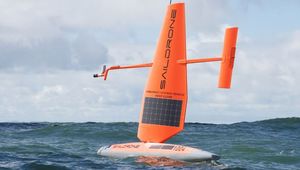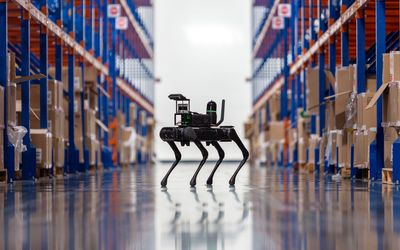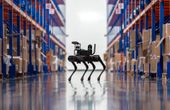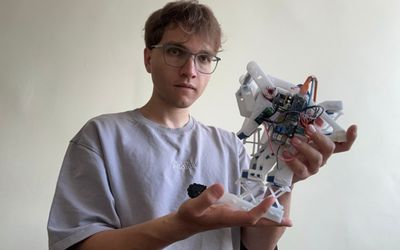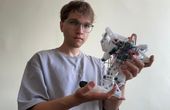Unitree Robotics Go1 EDU Plus
A quadruped robot by Unitree Robotics featuring 2D/3D LiDAR, five stereo depth cameras, and side-follow system for dog-like companionship and environment mapping.
Technical Specifications
| Dimension (Stand) | 645 × 280 × 400mm |
| Dimension (Fold) | 540 × 290 × 130mm |
| Weight | 12Kg±1.5Kg |
| Payload | ≈5Kg(Max~10Kg) |
| Speed | 0~3.7m/s (Max~5m/s) |
| Slope | 35° |
| Endurance | 1-2.5h |
| Power | 24 (BAT) |
| Battery | 6000mAh |
| Adapter | 24V, 6A |
| Super Sensory System | 5 Set |
| Ultrasonic Sensor | 3 Set |
| Processor | 2 Nano + (1 Nano or 1 NX) |
| Arm Controller | CPU Model Bcm2711 |
| Memory / Flash Memory | DDR4L 2gb / 32gb microSD |
| Built-In Controllers | 3 nVIDIA Nano |
| Impact absorber | Omnidirectional Flexible Buffer Structure |
| Won't be Injured when dropped from a height of 1.5m. | |
| Body/Thigh Joint (C1-8) | 520g |
| 23.70N.m | |
| Knee Joint | C1-8 × 1.5 ratio |
| 35.55N.m | |
| Lidar | Optional 2D or 3D |
| Extermal Interface | HDMI * 3 |
| Gigabit network port * 1 | |
| USB * 3 | |
| Integrated interface * 1 | |
| Features | Graphic Processing API (OTA) |
| Research Programming API | |
| Python Programming API | |
| HAI 1 Human Recognition | |
| APP Top View | |
| 4G or 5G | |
| Foot Force Sensor | |
| Multifunction Extension Interface |
Overview
An upgrade from traditional wheeled and tracked inspection robots, quadruped robots with discrete footholds adapt to various terrains, like steps, slopes, terrains, and mountains. They complete a series of work using GPS, a robotic arm, testing equipment, and lidar. They suit best for intelligent construction, security patrol, and search and rescue. These robots likewise provide work and services in electric power, mineral collection, and petrochemicals through patrol inspection, material transport, and exploration.
The quadruped robot Go1 EDU Plus is the high-range model among the consumer-level Go1 series from Unitree Robotics. It boasts 3 processors, adaptive joints, 5 depth cameras, 2D/3D LiDAR, and a side-follow system. The robot supports Python programming, Research Programming Interface, and a wireless 4G/5G connection.
Design
The robot spans 645 x 280 x 400mm when standing and 540 x 290 x 130mm when folded. It weighs approximately 12kg with a normal payload of 5kg and a maximum of 10kg. It slopes at a 35-degree angle and can run for a maximum speed of 3.7-5m/s. Aside from the 2-Nano processor is an additional 1 nano or 1 NX. The CPU Model Bcm2711 serves as the arm controller, along with the 3 Nvidia Nano built-in controllers. The robot houses a DDR4L 2GB memory and an additional 32GB micro SD as flash memory.
Joints & Motors
The joints exhibit a 12 degree of freedom, increasing stability, especially when moving through stairs. The Body/Thigh Joint Motor design can adapt to various mechanical equipment as it can achieve an instantaneous torque of 23.7 N·m. Meanwhile, the Knee Joint has a 35.55 N·m instantaneous torque.
The low-noise and lightweight yet durable power joints require no wires since the motors already connect joints seamlessly to the body. The industrial grade cross roller bearing contradicts the axial impact for extremely high precision. There is also a patented heat dissipation system built around the knee joint motor. Lastly, the Omnidirectional flexible buffer structure acts as an impact absorber, freeing the device from injury when dropped 1.5m high.
Sensory System - Stereo Depth Cameras & Voice Module
Creating the omniscient view of the robot are 5 stereo depth fish-eye cameras. These cameras work together to capture the view, which is accessible in the mobile app Unitree Robotics Go1. AI post-processing is also available, along with 3 sets of hypersonic sensors with 150 x 170° lens angle. The voice module functions act like a walkie-talkie linking the robot's surroundings and the controller. It also paves the way for receiving audio data from areas that are unfit for human exploration. The same app, Unitree Robotics Go1, allows this communication feature.
Robosense RS-LiDAR-16
The 16-beam RS-LiDAR-16 is a miniature LiDAR with a range of 150m and an accuracy of 2cm. This feature serves well for autonomous driving, UAV mapping, and environment mapping. The compactly housed RS-LiDAR-16 has 16 laser/detector pairs that rapidly spin, sending out high-frequency laser pulses. The pulses scan the environment, continuously collecting 3D point clouds in real time. A material's reflectivity allows the machine to see as it gathers data for navigation, localization, and obstacle avoidance.
RPLiDAR Slamtec Mapper
The Slamtec MApper integrates real-time localization, navigation, and map-building. It utilizes a high-performance SLAM engine combined with the power of a laser range scanner. SLAMTEC 3rd generation SLAM is a high-performance graph optimization that easily performs indoor and large outdoor environment mapping, aided by the mapping technology SharpEdge. It is complete with SDK, a cross-platform allowing coherent ROS environment integration. Likewise, Slamtec Mapper can serve as a laser range scanner on its own.
Battery
Go1 Pro has a lithium-ion power cell with a 6000mAh capacity and an endurance time of 1-2.5 hours—enough to meet every need of the robot’s routine operation. The battery management system (BMS) keeps track of the battery status, ensuring a stable and safe operation.
Intelligent Side-follow System
Go1 Pro adopts the patented wireless vector control and positioning technology. It walks alongside a human, positioned across the lateral peripheral vision for harmonious and safe human-machine interaction. The robot acts respectively on the user's position and obstacles. The side-follow system helps the robot choose better routes, especially in complex environments.
APP Top View
Aside from an omnidirectional view, Go1 Pro’s ultra-wide angle video image transmission gives users a view of the surrounding terrain—leading to a simple and convenient operation as if being present on the scene.
Software
A user PC will directly connect Go1 Pro with Ethernet, controlled by the airborne dual master and the bottom controller. The open high-level control is capable of sending high-level motion commands, like forward, backward, left, and right movement to the robot. Developers also have the convenient visual perception call mode for possible secondary development. The open-bottom control reads and controls every robot motor and sensor. Combined with low-delay data and image transmission, the robot can realize mutual data transmission in real time.
Where to find it

Trossen Robotics
Whether you're a researcher at the top of your field or new to robotics & looking for a solution, we've got you covered.


